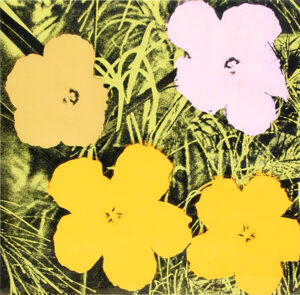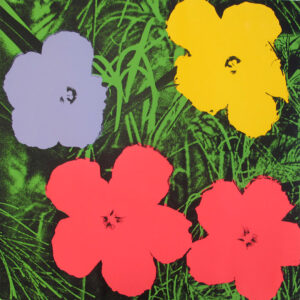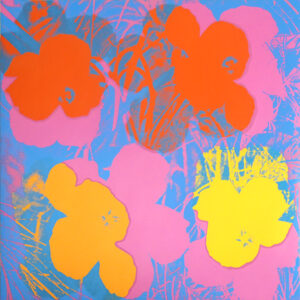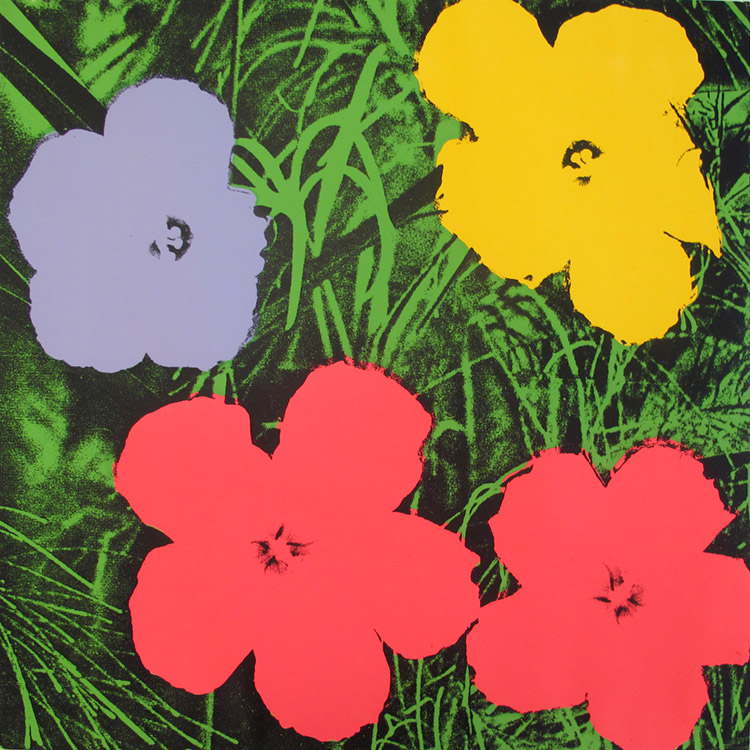Unveiling the Beauty of Andy Warhol Flowers
How did Andy Warhol’s depiction of flowers differ from traditional flower paintings?
Andy Warhol’s depiction of flowers differed from traditional paintings by using vivid and unnatural colors, repetition, and a commercial printing technique. His approach was more about mass production and consumer culture, challenging the traditional notions of art and beauty.

Andy Warhol, Flowers 67, from Flowers Portfolio, 1970
Key Highlights
- Andy Warhol’s Flowers series is iconic collection of screen prints that became popular in the art world.
- The inspiration behind Warhol’s Flowers series was a photograph of hibiscus flowers taken by Patricia Caulfield.
- Warhol’s transition from celebrities to flora in his artwork is a significant factor in the success of the Flowers series.
- The Flowers series showcases Warhol’s unique techniques and styles, including the use of the silkscreen technique.
- The color palette used in Warhol’s floral pieces adds to the overall significance and impact of the artwork.
- The cultural impact and reception of Warhol’s Flowers series have been prominent in popular culture and art history.
Introduction
Andy Warhol, one of the most iconic artists of the 20th century, is known for his groundbreaking work in the pop art movement. His vibrant and bold artwork has become a symbol of the modern art world. One of his most famous series is the Flowers series, which showcases his unique style and artistic vision. The Flowers series is a collection of screen prints that depict various types of flowers in Warhol’s signature style. These prints have become highly sought after by collectors and art enthusiasts around the world.
The Genesis of Warhol’s Floral Fascination
The inspiration behind Warhol’s Flowers series can be traced back to a photograph of hibiscus flowers taken by Patricia Caulfield for Modern Photography magazine. This colour photo of seven hibiscus flowers caught Warhol’s eye and sparked his fascination with floral imagery. He was drawn to the vibrant colours and simple composition of the photo, found in the June 1964 issue of Modern Photography, and decided to use it as the basis for his artwork. Little did he know that this decision would lead to the creation of one of his most iconic and beloved series, warhol’s image.
Inspiration Behind the Iconic Flower Series
The Flowers series was not without controversy. The original photograph used by Warhol was taken by Patricia Caulfield and was published in Modern Photography magazine. Caulfield later sued Warhol for copyright law infringement, claiming that he used her image without permission. In 1966, Caulfield won her lawsuit against Warhol and was awarded damages for the changes Warhol made to her original photograph, known as Caulfield’s original photograph. Despite the legal battle, Warhol’s Flowers series continued to captivate audiences with its vibrant colors and unique portrayal of floral subjects inspired by Caulfield’s original photograph.

Andy Warhol, Flowers 73, from Flowers Portfolio, 1970
Transition from Celebrities to Flora
Warhol was known for his portraits of celebrities, such as Marilyn Monroe, and his iconic Campbell’s Soup Cans artwork. However, with the Flowers series, Warhol shifted his focus from famous figures to the beauty of nature, specifically the vibrant and colorful transition from celebrities to flora, represented by his famous Campbell’s Soup Cans. This change in subject matter allowed Warhol to explore new artistic themes and challenge traditional notions of art. By depicting flowers, or rather the familiar Campbell’s Soup Cans, in his artwork, Warhol created a connection between popular culture and the natural world, blurring the lines between high and low art. This can be seen as a reflection of the changing times in the 1960s, where consumerism and mass production were becoming increasingly prevalent in society.
The Artistic Journey of Andy Warhol’s Flowers
Andy Warhol’s Flowers series marked a significant artistic journey for the renowned artist. The series showcased a departure from his previous work, which often featured celebrities and consumer products. Instead, Warhol turned his attention to still lifes and explored the beauty of everyday objects. The Flowers series allowed Warhol to experiment with new techniques and styles, creating a body of work that would have a lasting impact on the art world.
Techniques and Styles Explored
In the Flowers series, Warhol utilized his signature silkscreen technique to create vibrant and visually striking prints. This technique involved applying layers of ink onto a screen to transfer the image onto the canvas. Warhol’s use of bold and contrasting colors added depth and dimension to the floral subjects, making them pop off the canvas. The mass media-inspired style of the Flowers series not only reflected Warhol’s fascination with popular culture but also challenged traditional notions of fine art by incorporating his own layers of colour into the images.
Significance of Color in Warhol’s Floral Pieces
Color played a significant role in Warhol’s Floral pieces. The vibrant and vivid colors used in the series created a sense of energy and life. Warhol’s use of color was deliberate and strategic, as he often manipulated the hues to enhance the visual impact of the artwork. The flower in the upper corner of the compositions became a signature element of Warhol’s floral pieces, adding a touch of whimsy and intrigue. The colors in Warhol’s floral prints were sourced from his own silkscreens, allowing him to create unique and captivating compositions.

Andy Warhol, Flowers 66, from Flowers Portfolio, 1970
Cultural Impact and Reception of the Flower Series
Warhol’s Flowers series had a significant cultural impact and reception. The series became synonymous with the pop art movement, which challenged traditional notions of art and popular culture. Warhol’s floral prints were embraced by audiences around the world, and his artwork became a symbol of the changing times. The Flowers series also contributed to Warhol’s status as an influential artist in the art history canon, solidifying his place as a leading figure in the pop art movement.
Public and Critical Reception Over the Years
The public and critical reception of Warhol’s Flowers series has been overwhelmingly positive. The vibrant and eye-catching prints have captured the attention of art enthusiasts and collectors alike. The Flowers series has been featured in major exhibitions and galleries around the world, further cementing its status as an iconic body of work. Warhol’s use of everyday objects and popular culture references in his artwork resonated with audiences, challenging traditional notions of what constitutes art. The Flowers series continues to be celebrated for its boldness, creativity, and cultural significance.
Warhol’s Flowers in Modern Pop Culture
Warhol’s Flowers series has had a lasting impact on modern pop culture. The iconic image of the vibrant flowers has been reproduced and referenced in various forms of media, from advertisements to fashion designs. The Flowers series not only influenced contemporary artists but also became an integral part of the visual language of popular culture. Warhol’s ability to capture the essence of beauty in everyday objects, like flowers, resonated with audiences and continues to inspire artists and designers to this day. The Flowers series remains an important and influential body of work in the realm of pop art.
Exploring the Themes in Warhol’s Flowers
Warhol’s Flowers series explores several themes, including the dichotomy between nature and commercialism, as well as the beauty found in the mundane. By depicting flowers, a symbol of nature’s beauty, through the lens of mass media and consumer culture, Warhol blurs the lines between the natural and the artificial. Through his artwork, Warhol challenges traditional notions of what is considered art-worthy and elevates the ordinary to the extraordinary.
Nature vs. Commercialism
In the Flowers series, Warhol juxtaposes the natural beauty of flowers with the influence of commercialism and mass media. By appropriating images from magazines and advertisements, Warhol questions the distinction between high art and popular culture. The use of flowers, typically associated with nature and beauty, in the context of mass-produced consumer goods challenges traditional notions of the artistic subject matter. Warhol’s Flowers series invites viewers to reconsider their perception of art and to question the influence of commercialism on our society, including his exploration of public figures such as John and Jackie Kennedy.
Beauty in the Mundane
Warhol’s Flowers series highlights the beauty that can be found in the mundane. By focusing on incomplete flowers and manipulating the original image, Warhol transforms a seemingly ordinary subject into a work of fine art. The repetition and abstraction in the floral compositions create a sense of rhythm and harmony, elevating the ordinary to the extraordinary. Warhol’s ability to find beauty in everyday objects challenges viewers to see the world around them in a new light and appreciate the aesthetic value of the seemingly mundane.
The Technical Process Behind the Creation
Warhol’s Flowers series was created using a combination of screen printing techniques and the manipulation of a photograph of hibiscus flowers. The silkscreen technique allowed Warhol to transfer the image onto the canvas, layering ink to create vibrant and visually striking prints. By manipulating and cropping the original photograph, Warhol added his own artistic touch and transformed the image into his iconic floral compositions. The technical process behind the creation of the Flowers series showcases Warhol’s innovative and experimental approach to art-making.
Screen Printing Techniques
The screen printing technique, also known as the silkscreen technique, played a crucial role in Warhol’s creation of the Flowers series. Using a fine mesh screen, ink is forced through the screen onto the canvas, creating a printed image. Warhol’s use of this technique allowed him to produce multiple prints with consistent colors and compositions, resulting in a series of visually cohesive artworks. The silkscreen technique also allowed Warhol to experiment with different color combinations and layering, adding depth and visual interest to his floral prints. The screen printing techniques utilized by Warhol in the creation of the Flowers series are a testament to his innovative approach to art-making.
From Photographs to Pop Art Icons
The Flowers series began with a relatively unknown photograph of flowers, taken by Patricia Caulfield for Modern Photography magazine. Warhol appropriated this image to create his iconic floral compositions. However, this appropriation led to a copyright law infringement lawsuit filed by Caulfield. Despite the legal battle, Warhol’s Flowers series became an important part of the pop art movement and cemented his reputation as a groundbreaking artist. The transformation from a photograph into a pop art icon is a testament to Warhol’s ability to redefine the boundaries of art and challenge traditional notions of authorship and originality.
Notable Collections and Exhibitions
Warhol’s Flowers series has been featured in major museums and private collections around the world. The vibrant and visually captivating prints have captured the attention of art enthusiasts and collectors alike. Some notable collections that feature Warhol’s Flowers series include the Museum of Modern Art in New York, the Centre Pompidou in Paris, and the Tate Modern in London. The Flowers series has also achieved notable sales, with prints and portfolios fetching high prices at auction houses and galleries.
Major Museums Featuring Warhol’s Flowers
Warhol’s Flowers series has been prominently displayed in major museums across the globe. The Museum of Modern Art in New York has a significant collection of Warhol’s artwork, including his Flowers prints. The Centre Pompidou in Paris is another notable institution that features Warhol’s Flowers series as part of its permanent collection. These major museums recognize the cultural significance and artistic value of Warhol’s Flowers series, showcasing the impact and lasting influence of his work in the art world.
Private Collections and Notable Sales
Warhol’s Flowers series is highly sought after by private collectors, with notable sales and acquisitions in recent years. Private collections often include limited edition prints and portfolios of the Flowers series, showcasing the continued interest and demand for Warhol’s artwork. Notable sales of Warhol’s Flowers prints have reached impressive prices, with some fetching millions of dollars at auction. Private collectors and art enthusiasts recognize the value and significance of Warhol’s Flowers series, making it a coveted addition to their collections. The table below highlights some notable sales of Warhol’s Flowers prints.
Artwork | Sale Price |
Flowers (F. & S. II.65) | $1.8 million |
Flowers (F. & S. II.70) | $2.5 million |
Flowers (F. & S. II.67) | $1.4 million |
Flowers (F. & S. II.73) | $1.2 million |
Flowers (F. & S. II.66) | $2.1 million |
Flowers (F. & S. II.72) | $1.6 million |
The Market for Warhol’s Floral Prints Today
The market for Warhol’s floral prints remains strong today, with high demand and impressive auction prices. Collectors and investors recognize the cultural significance and artistic value of Warhol’s Flowers series, making it a popular choice for investment. The vibrant and visually striking prints continue to captivate audiences and are highly sought after by collectors. Investing in Warhol’s flower prints can be a lucrative opportunity, given their historical significance and continued popularity in the art market.
Investing in Warhol’s Flower Prints
Investing in Warhol’s flower prints can be a wise decision for collectors and investors. The Flowers series has a long-standing reputation in the art market and has consistently achieved high prices at auctions and galleries. The market trends for Warhol’s flower prints indicate a strong demand and appreciation for these artworks. Collectors who invest in Warhol’s flower prints through Masterworks Fine Art Gallery, a curated site featuring artists that collectors want, can expect potential financial growth and increased value over time. However, it is important to stay informed about the market trends and seek advice from art experts or consultants before making any investment decisions. The market for Warhol’s flower prints is dynamic and constantly evolving, making it crucial to stay updated with the latest market trends.
Trends in Auction Prices and Demand
The auction prices for Warhol’s flower prints have shown steady growth over the years, reflecting the continued demand and appreciation for his artwork. The vibrant and visually striking nature of the Flowers series resonates with collectors and art enthusiasts, contributing to the strong market demand. Auction houses and galleries have witnessed competitive bidding for Warhol’s flower prints, driving the prices higher. The market trends indicate a sustained interest in Warhol’s floral artwork, fueled by the artist’s iconic status and the enduring popularity of the pop art movement. As popular culture continues to embrace Warhol’s legacy, the demand for his flower prints is expected to remain strong, making them a valuable investment for collectors.
Conclusion
In essence, Andy Warhol’s Flowers captivate with their timeless allure, reflecting a blend of creativity and cultural impact. From the genesis of his floral fascination to the technical mastery behind each creation, Warhol’s artistry transcends mere aesthetics, delving into deeper themes of nature, commercialism, and the mundane beauty that surrounds us. The market for his floral prints continues to thrive, offering both investment opportunities and a gateway to understanding the evolution of contemporary art. Discover the enduring legacy of Warhol’s Flowers through major collections, exhibitions, and their lasting influence on artistic expression.
Frequently Asked Questions
What Makes Warhol’s Flowers Unique in His Oeuvre?
Warhol’s Flowers series stands out in his oeuvre for its iconic image and subject matter. Unlike his portraits of celebrities or consumer products, the Flowers series explores the beauty of nature and challenges traditional notions of art. Its vibrant colors and repetitive compositions have become synonymous with Warhol’s artistic vision and have left a lasting impact on the art world.
How Can I Authenticate a Warhol Flower Print?
To authenticate a Warhol flower print, it is important to consult with art experts and professionals who specialize in Warhol’s artwork. They can verify the authenticity of the print by examining the silkscreen techniques used, comparing it to known examples, and conducting research on its provenance. It is also important to be aware of copyright law infringement cases related to Warhol’s Flowers series, as this can impact the authenticity and value of the artwork.
Are There Any Undiscovered Warhol Flowers?
While it is unlikely that there are undiscovered Warhol Flowers prints in the traditional sense, new editions or variations of the series may still be uncovered. With ongoing research and advancements in art history, there is always a possibility of unearthing previously unknown or rare examples of Warhol’s floral artwork. Market trends and auction sales can also reveal lesser-known or previously underappreciated prints, adding to the overall understanding and appreciation of Warhol’s Flowers series.
How Do Warhol’s Flowers Influence Contemporary Art?
Warhol’s Flowers series continues to have a significant influence on contemporary art. The vibrant colors, repetitive compositions, and exploration of popular culture themes found in the Flowers series have inspired numerous artists working today. The impact of Warhol’s Flowers can be seen in various contemporary art forms, including paintings, prints, installations, and digital artworks, demonstrating the enduring relevance and influence of his iconic floral compositions.






